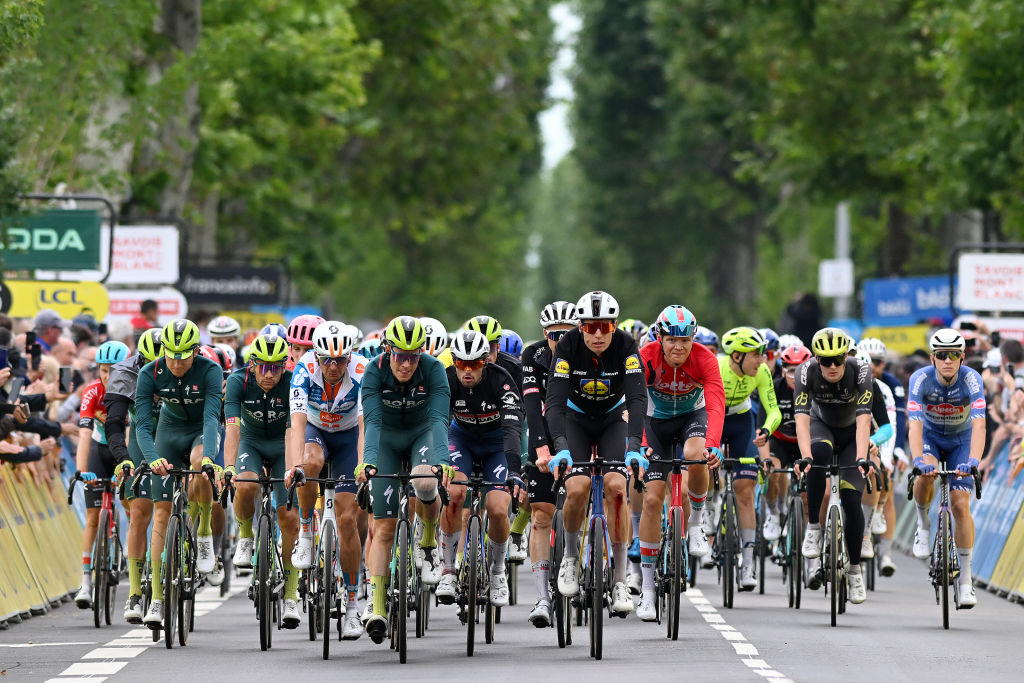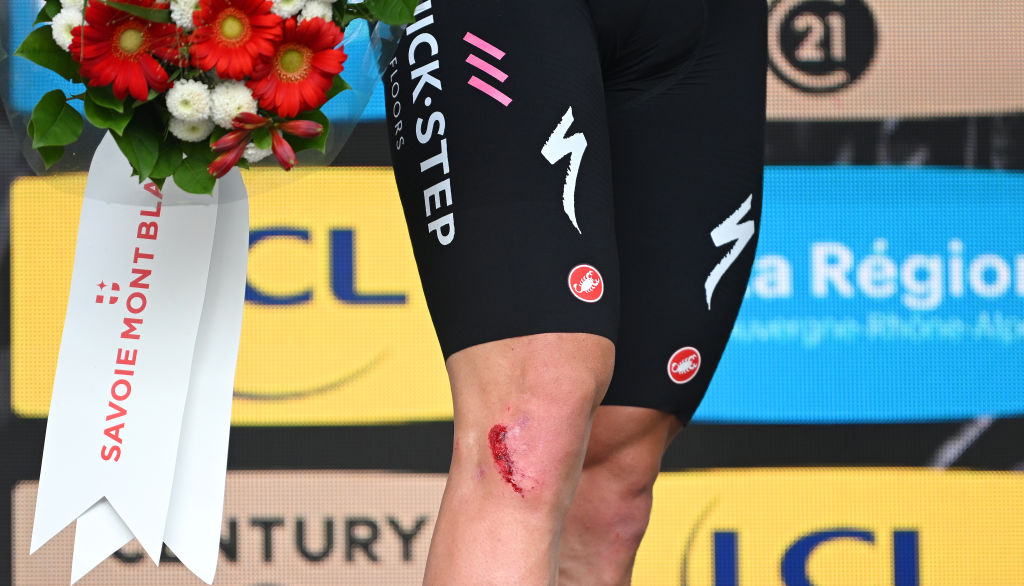'Another dark day for cycling' - Critérium du Dauphiné peloton rues latest mass crash
Huge pileup late on stage 5 sees 'a good 50 riders fall' and not enough ambulances to continue with the race

Midway through Wednesday afternoon, a battered and bruised Critérium du Dauphiné peloton picked its way across the finish line of stage 5 still digesting the consequences of the horrendous mass crash that had ripped through the bunch barely an hour before.
Cuts and bloodied elbows, hips and legs were on view throughout the peloton on the neutralised 20-kilometre run-in to Saint Priest, riders in no rush to complete the final part of what should have been an inoffensive and probably uneventful transition stage.
The vast majority of the riders were able to head straight to the team buses, with only race leader Remco Evenepoel (Soudal-QuickStep) and the other riders heading the secondary classifications directed towards a lacklustre podium ceremony.
Three days of tough Alpine riding now face the Critérium du Dauphiné peloton, which will hardly be ideal for those who came off worst in the crash but were able to continue. But the question of what exactly happened in the latest mass crash to strike professional cycling this year will surely linger for some time to come, too.
"It’s again quite a dark day for cycling, unfortunately,” a grim-faced Evenepoel told reporters afterwards, in an unspoken reference to the crashes that have affected the sport in 2024. Amongst their number, of course, is the one that saw him abandon Itzulia Basque Country with a broken collarbone, while others like Jonas Vingegaard (Visma-Lease a Bike) and Jay Vine (UAE Team Emirates) fared even worse.
"Overall it's OK, I crashed on my right side. I crashed on my head as well so the helmet saved me today. There are guys in a worse situation than I am now so I hope and I wish everybody a full recovery," Evenepoel added.
Evenepoel said that he had no idea how the crash actually happened, just that riders were fighting for position on the descent. But he did know that he had an injured knee that would need checking as a result of the mass pile-up.
The latest race content, interviews, features, reviews and expert buying guides, direct to your inbox!
"The positive thing about my crash is I don’t have to leave the race but I actually had quite a big blow to my knee. Another bike came on my knee and it was quite painful.
“But it was a bad situation for the whole bunch, so all my best wishes and speedy recovery to the guys on their way to hospital. It’s again quite a dark day for cycling, unfortunately."
“Everybody had that feeling that - it’s a little bit slippy maybe,” British National Champion Fred Wright (Bahrain Victorious) added to ITV and other reporters about the mass pileup that sparked at least five abandons.
“We were racing to the top of that climb to get into a good position, it was a straight road but maybe a touch of the brakes, bikes going from under you…when that happens in front of you, there’s not much you can do.
“It’s a memory that I’m going to keep for a long time, I was just sliding downhill for a long time, on my back, a good 300 metres, just sliding and hoping to stop. I didn’t know where my bike was.
“So yeah, pretty scary stuff. A lot of guys came down. I think it was the right decision to neutralise it, with so many people down.”
Wright estimated that a “good 75%” of the peloton were caught up in the crash, one way or another, and that the speed the bunch was travelling was around 60 or 70 kph. His own damage was largely to his bike - which he had to walk back up the road to find - and race shoes, but like Evenepoel, he wished a speedy recovery to those who were not so lucky.
Around 50 riders down

“I think around 50 riders actually went down,” said race director Thierry Gouvenou to reporters at the finish. “And I know there are plenty of riders with injuries needing curing this evening.”
Gouvenou confirmed that the critical issue when it came to neutralising the race was that there were not enough ambulances to continue with the peloton had it continued. The occasionally heavy rainfall meant expecting riders to wait until the ambulances returned rendered the situation even more complicated. Then there was the fact the stage was just 20 kilometres from the finish when the crash happened. Taken globally, suspending the stage was the only option.
Riders like Chris Froome (Israel-Premier Tech), himself the victim of a very bad fall just before the Critérium du Dauphiné six years ago, spent some time with the race organisation's lead car, telling them what he thought.
But Gouvenou said that while multiple riders, not just Froome, had expressed their opinions, the decision had in any case been taken by race organisers and the UCI in conjunction with the medical services, and in a scant 10 minutes after the crash happened. As Gouvenou put it, “the crash had an enormous impact on the race,” and “our medical service was overwhelmed”.
So far, five riders have been confirmed as abandoning as a result of the crash, - Dylan van Baarle and Steven Kruijswijk (Visma-Lease a Bike), Laurens Huys (Arkéa-B&B Hotels), Axel Mariault (Cofidis) and Rai Kepplinger (Bahrain Victorious). It goes without saying though, that that number may well rise.
The question as to whether this latest crash was one that might never have needed to happen is one which will continue to be discussed for weeks to come.
One factor that could have contributed was that, as Wright pointed out, the weather had started dry but then turned wet meaning that some riders’ tyre pressures were perhaps not set for the less favourable conditions that began mid-way through the 167-kilometre stage.
But with not one but two crashes happening simultaneously on a straight, apparently well-surfaced section of downhill actually answering that is almost certainly impossible. Conditions had already been risky enough earlier on for the peloton briefly to neutralise the chase of the day’s break around 50 kilometres to go on a windy, wet downhill, before full-on racing resumed - only for the double mass crash to happen.
“Could this have been avoided? I don’t know, probably not, maybe yes. It’s a race situation,” Evenepoel said.
“It was so slippery that that as soon as you braked you fell,” Romain Combaud (Team dsm-Firminich-PostNL) told CyclingPro and other media. “You can’t blame the organisation, the riders, you can’t blame anybody. It’s just the road conditions themselves.”
One of the first riders, post-crash, to point out that a neutralisation was necessary, Combaud also praised the organisation and UCI for opting to do so so quickly, calling it a “wise decision”.
But although he had only minor injuries this time, Combaud himself said that it was impossible for him, personally, to avoid the thoughts of a previous serious crash in the Dauphiné, last year on stage 2 when he broke his collarbone. And as he put it, too, the wider perspective on a such mass fall had to be borne in mind, too and hopefully spark further debate on what could be done about them.
“They [crashes] are part of cycling, but they are happening more and more frequently, so in the years to come, we have some good questions to ask ourselves,” he concluded.
Alasdair Fotheringham has been reporting on cycling since 1991. He has covered every Tour de France since 1992 bar one, as well as numerous other bike races of all shapes and sizes, ranging from the Olympic Games in 2008 to the now sadly defunct Subida a Urkiola hill climb in Spain. As well as working for Cyclingnews, he has also written for The Independent, The Guardian, ProCycling, The Express and Reuters.
